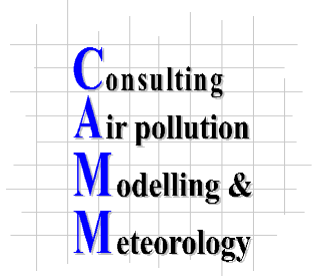CAMM and Dr Graeme Ross have undertaken research and development in air pollution modelling and meteorology for almost 40 years. These include and build on the activities developed by Dr Ross when he was Professor and Foundation Director of the Centre for Applied Mathematical Modelling at Monash University. Dr Ross and his staff have undertaken, or had significant involvement in, developing transport and dispersion models which are currently being used by numerous agencies in both Australia and overseas.
Model Development and Evaluation | Major Air Quality Assessment Projects | Overseas Projects | Current Research & Devlopment
Model Development and Evaluation
- AUSPLUME air quality model – a number of projects involving the development and application of the AUSPLUME plume dispersion model. The AUSPLUME model was developed under contract to the EPA of Victoria and until recently was the major model used throughout Australia for the regulatory assessment of emissions to air. CAMM, in conjunction with EPAV, upgraded AUSPLUME to include a WINDOWS based graphical user interface and graphical software, and have completed major upgrades of the model.
- AERMOD air quality model – completion of a major review of regulatory modelling and AUSPLUME for EPAV, with a recommendation (accepted) that the USEPA regulatory model AERMOD be adopted to replace AUSPLUME as the regulatory assessment model for Victoria. The review included a comprehensive ‘consequence analysis’ and input to the EPAV guidelines for using AERMOD.
- AUSROADS air quality model – development of Australia’s first regulatory model AUSROADS to assess air pollution impacts from roads.
- AUSTOX/AUSCHEM Emergency preparedness and response models - development of AUSTOX, Australia’s first computer-based model which provides a fast accurate assessment of the potential impact of releases to air of toxic and hazardous materials. The model includes high performance modules for a wide range of release types; heavier-than-air vapour or gas behaviour; and its puff-based approach allows prediction of the time evolution of concentration or dosage levels to be displayed on user-created maps. Modified forms of the software were developed for risk assessment under a National Teaching Company Scheme grant with VRJ Risk Engineers Pty Ltd; for integration into the Defence Science and Technology Organisation (DSTO) VULCAN software for military response applications; for fires emitting toxic vapour; and for integration into the MAPINFO geographical information system. AUSTOX was extended to include impact assessments for release scenarios resulting in pool and jet fires as well as explosions. The resulting model, called AUSCHEM, was developed in conjunction with the Queensland Department of Emergency Services (CHEM UNIT).
- Diagnostic Wind Field Modelling - Development and Validation - a series to NERDDC funded projects over 4 years to develop and validate NUATMOS (a 3D diagnostic wind field model) for use in air pollution studies in complex terrain. This study focussed on the Latrobe Valley.
- Validation of Air Pollution Dispersion Models - a two year NERDDC funded study to develop standardised sets of data for testing the accuracy of mathematical models for predicting the dispersion of air pollution from tall chimneys, and to use the data sets to test a range of models of interest and importance for Australian electricity authorities.
- Diffusion and wind modelling for complex topography – development of the Topographical Air Pollution Analysis System (TAPAS). This system employs NUATMOS for the wind field model. Funded by USDA under subcontract to research contract No. 28-K5-355 with US. Forest Service.
- CALPUFF/AUSPUFF – a project involving the integration of the NUATMOS diagnostic wind field model, into the AUSPUFF regulatory air pollution dispersion model structure, as developed by Sigma Research Corporation and later replaced by CALPUFF.
- Kernel Density Estimation Applied to the Lagrangian Particle Model - a one year study funded by NOAA/CSU and the U.S. National Park Service to implement the kernel density estimation technique into the dispersion estimation component of the Colorado State University (CSU) Lagrangian particle model.
- Development of EGATPUFF and DUSTMAN, Thailand - a project involving the development of an Air Modelling Systems for the Electricity Generating Authority of Thailand (EGAT). The modelling systems were based on a modified forms of the CALPUFF modelling software, together with the development of specially tailored Graphical User Interfaces (GUIs). Separate modelling systems (EGATPUFF and DUSTMAM) were designed to assess the impact of mine and power station emissions, respectively. Both systems underwent a performance evaluation using data from an on-site monitoring program. The project included installation of the modelling systems and training in their application.
- Development of NWIA Modelling System, Tasmania - a project involving the development of an Air Modelling System for assessing baseline conditions and the impact of potential industrial developments in the NWIA airshed. The modelling system is based on ‘standard/characteristic’ meteorology (determined using the CSIRO TAPM model), a modified form of the CALPUFF modelling software, together with the development of a specially tailored GUI. The project included installation of the modelling system and training in its application.
- Development of RTABBPUFF (Bell Bay, Tasmania) - a project involving the development of an Air Modelling System for the Rio Tinto Aluminium Bell Bay (RTABB) Smelter. The modelling system was based on TAPM meteorology, a modified form of the CALPUFF modelling software, together with the development of a specially tailored GUI. Development and evaluation of the modelling system was on-going, with the production of annual regulatory assessments.
Major Air Quality Assessment Projects
- Latrobe Valley Airshed Study – a 10 year study to assess the capability of the airshed to assimilate emissions from existing and proposed developments. Contributions to the study included wind and dispersion model development, evaluation and application which was supported by Department of Energy and Resources (NERDDC) grants and the "electricity generation authorities" throughout Australia.
- Tamar Valley Airshed Study – a study to determine the characteristic air pollution meteorology of the Tamar Valley in Tasmania. The study involved the development of an "intelligent" wind field model for complex terrain which is capable of incorporating both observations and predictions from a prognostic sub-model within a diagnostic framework. The study was conducted for the Department of Environment and Land Planning as part of a consortium with CSIRO DAR, University of Tasmania and Stevenson EMF Pty. Ltd.
- North West Industrial Area Study (NWIA), Tasmania – an air quality assessment for a baseline study for Tasmanian Department of State Development.
- Hydro Tasmania – Emergency Power Projects – a study to investigate the air quality impacts arising from possible options for emergency power in Tasmanian. The options considered included an assessment of diesel powered generation units at various sites, and the possible reintroduction of the Bell Bay Power Station. The modelling assessments were based on TAPM predictions with photochemistry.
- EPAV Air Quality Improvement Plan, Geelong – a study involving the provision of TAPM simulations in support of an Environment Protection Authority of Victoria (EPAV) air quality improvement plan for the Port Phillip Air Quality Control Region. The project involved running TAPM with full photochemistry, and input from the EPAV emissions inventory, for the assessment of alternative scenarios and priority actions defined by EPAV to improve air quality. CAMM’s contribution was for the Geelong region, with CSIRO examining the Melbourne region.
- Lane Cove Tunnel - Air Impact Assessment – the conduct of a full air impact assessment for the Lane Cove Tunnel in Sydney. The work was conducted for both the tender phase and the final design and construct phase and was conducted for the Thiess John Holland Joint Venture. The modelling component was based on TAPM simulations of the meteorology, with input to the CALPUFF dispersion model.
- RioTinto/Comalco (Bell Bay) Local Airborne Contaminant Transport Study – a study to develop a site-specific airshed modelling and management system, which is integrated with, and evaluated using, data bases obtained during a series of intensive observing periods designed to capture characteristic meteorological phenomena and obtain information on the key mechanisms governing these conditions. Ths study involved the use of a specially configured version of the AUSPUFF/CALPUFF modelling software which included the AUSMET(NUATMOS) meteorological model. The study was conducted as part of a consortium with the University of Tasmania and CSIRO DAR. Separate studies for regulatory purposes were also conducted.
Overseas Projects
- Lignite Mine Development Project Phase III, Thailand - In-Pit dust dispersion modelling – The development of a model for predicting the effects of topographical change and alternative work practices in the Mae Moh Lignite Mine in Thailand. This work was conducted for the Electricity Generating Authority of Thailand under contract to Kinhill Engineers and was supported by AIDAB (Australian Industry Development Abroad).
- Electricity Generating Authority of Thailand - Airshed Study for Predicting and Forecasting of Sulphur Dioxide Impact Events at Mae Moh, Thailand – The development of an Airshed Modelling System based on a modified form of the CALPUFF modelling software. The primary objective of this on-going project was to develop and evaluate an air quality modelling system for predicting the impact of Sulphur Dioxide emissions from power plants at Mae Moh. A parallel program was conducted to examine historical meteorological, monitoring, and emissions data in order to develop an approach to forecasting Sulphur Dioxide impact events. This work was carried out under a Joint EGAT/AusAID agreement.
- U.S. Bureau of Land Management and U.S. Forest Service Projects – a series of projects funded by these U.S.A. organisations under cooperative agreements to develop and apply models for assessing the impact of mining (and other industrial) emissions on the air quality in National Forests and Monuments.
- SAIL Environmental Management and Pollution Control Project – an air quality impact study undertaken for BHP Engineering and Kinhill Engineers Pty. Ltd. as part of an environmental management plan for the modernisation of four SAIL steel plants in India. This involved the revision and application of AUSPLUME. A two year study funded by the World Bank.
- Emergency Preparedness Modelling for Complex Terrain - EG&G Rocky Flats (U.S. Department of Energy) – a project funded by EG&G Rocky Flats (U.S. Department of Energy) to implement and evaluate the NUATMOS diagnostic wind field model as a component of a real-time computer model for atmospheric dispersion. The model was designed to run continuously for use in case of an accidental release from the Rocky Flats Nuclear Plant in Colorado, and served a geographic area of roughly 150 x 150 km, including the metropolitan Denver area and a portion of the Rocky Mountains.
Current Research & Development
The current research and development thrusts are in two major areas:
- Transport and Dispersion Modelling in Complex Terrain.
- Air Quality Modelling for Hazardous Waste Management and Emergency Preparedness.

